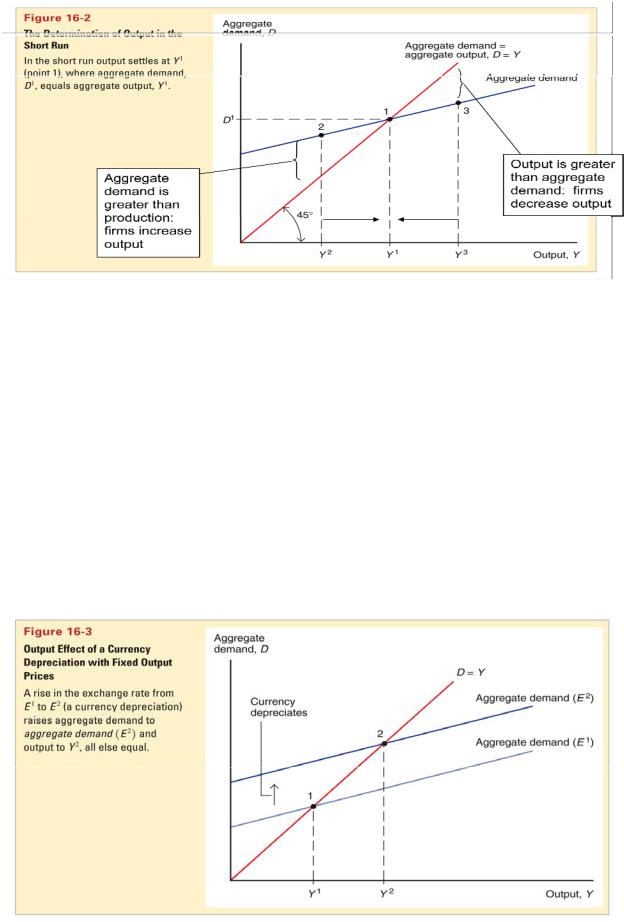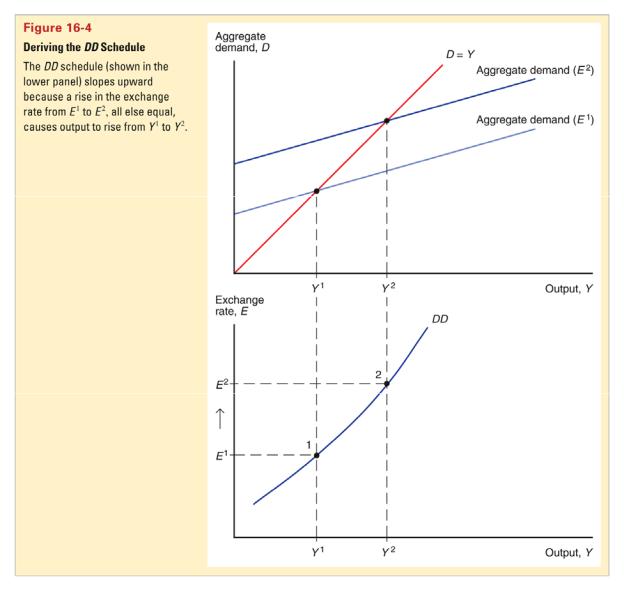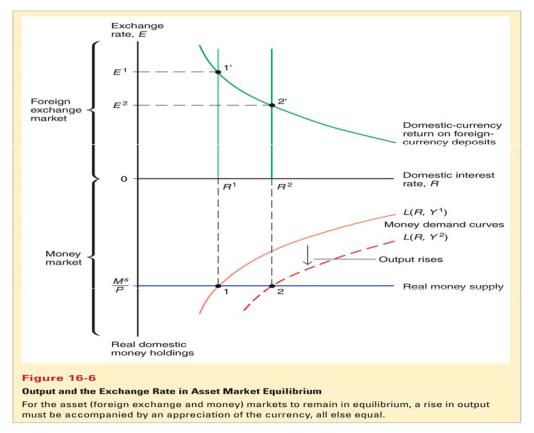
10686
.pdf•A short run model of asset market equilibrium
•A short run model for both output market equilibrium and asset market equilibrium
•Effects of temporary and permanent changes in monetary and fiscal policies.
•Adjustment of the current account over time.
•IS-LM model
Introduction
•Long run models are useful when all prices of inputs and outputs have time to adjust.
•In the short run, some prices of inputs and outputs may not have time to adjust, due to labor contracts, costs of adjustment or imperfect information about market demand.
•This chapter builds on the short run and long models of exchange rates to explain how output is related to exchange rates in the short run.
macroeconomic policies affect output, employment and the current account.
Determinants of Aggregate Demand
•Aggregate demand is the aggregate amount of goods and services that people are willing to buy:
1.consumption expenditure
2.investment expenditure
3.government purchases
4.net expenditure by foreigners: the current account
Determinants of Aggregate Demand
• Determinants of consumption expenditure include:
Disposable income: income from production (Y) minus taxes (T).
More disposable income means more consumption expenditure, but consumption typically increases less than the amount that disposable income increases.
Real interest rates may influence the amount of saving and consumption, but we assume that they are relatively unimportant here.
Wealth may also influence consumption, but we assume that it is relatively unimportant here.
•Determinants of the current account include:
Real exchange rate: prices of foreign products relative to the prices of domestic products, both measured in domestic currency:
EP*/P
•As the prices of foreign products rise relative to those of domestic products, expenditure on domestic products rises and expenditure on foreign products falls.
Disposable income: more disposable income means more expenditure on foreign products (imports)
How Real Exchange Rate Changes Affect the Current Account
•The current account measures the value of exports relative to the value of imports: CA ≈ EX – IM.
When the real exchange rate EP*/P rises, the prices of foreign products rise relative to the prices of domestic products.
The volume of exports that are bought by foreigners rises.
The volume of imports that are bought by domestic residents falls.
The value of imports in terms of domestic products rises: the value/price of imports rises, since foreign products are more valuable/expensive.

•If the volumes of imports and exports do not change much, the value effect may dominate the volume effect when the real exchange rate changes.
for example, contract obligations to buy fixed amounts of products may cause the volume effect to be small.
•However, evidence indicates that for most countries the volume effect dominates the value effect in 1 year or less.
•Therefore, we assume that a real depreciation leads to an increase in the current account: the volume effect dominates the value effect.
Determinants of Aggregate Demand
•Determinants of the current account include:
Real exchange rate: an increase in the real exchange rate increases the current account.
Disposable income: an increase in the disposable income decreases the current account.
•For simplicity, we assume that exogenous political factors determine government purchases G and the level of taxes T.
•For simplicity, we currently assume that investment expenditure I is determined exogenously.
A more complicated model shows that investment depends on the cost of borrowing for investment, the interest rate.

•Determinants of aggregate demand include:
Real exchange rate: an increase in the real exchange rate increases the current account, and therefore increases aggregate demand for domestic products.
Disposable income: an increase in the disposable income increases consumption, but decreases the current account.
Since total consumption expenditure is usually greater than expenditure on foreign products, the first effect dominates the second effect.
As income increases for a given level of taxes, aggregate consumption and aggregate demand increases by less than income.
Short Run Equilibrium for Aggregate Demand and Output

Short Run Equilibrium and the Exchange Rate: DD Schedule
•How does the exchange rate affect the short run equilibrium of aggregate demand and output?
•With fixed domestic and foreign price levels, a rise in the nominal exchange rate makes foreign goods and services more expensive relative to domestic goods and services.
•A rise in the exchange rate (a domestic currency depreciation) increases the aggregate demand for domestic products.
•In equilibrium, aggregate demand matches output.

DDschedule
•shows combinations of output and the exchange rate at which the output market is in short run equilibrium (aggregate demand = aggregate output).
•slopes upward because a rise in the exchange rate causes aggregate demand
and aggregate output to rise.
Shifting the DD Curve
•Changes in the exchange rate cause movements along a DD curve. Other changes cause it to shift:

1.Changes in G: more government purchases cause higher aggregate demand and output in equilibrium. Output increases for every exchange rate: the DD curve shifts right.
2.Changes in T: lower taxes generally increase consumption expenditure, increasing aggregate demand and output for every exchange rate: the DD curve shifts right.
3.Changes in I: higher investment demand shifts the DD curve right.
4.Changes in P relative to P*: lower domestic prices relative to foreign prices shift the DD curve right.
5.Changes in C: willingness to consume more and save less shifts the DD curve right.
6.Changes in demand for domestic goods relative to foreign goods: willingness to consume more domestic goods relative to foreign goods shifts the DD curve right.
Short Run Equilibrium for Assets
•We consider two asset markets when considering asset market equilibrium:
1.Foreign exchange market
interest parity determines equilibrium: R = R* + (Ee – E)/E
2.Money market
real money supply and demand determine equilibrium:
Ms/P=L(R,γ)
A rise in income and output causes real money demand to increase.
3.When income and output increase,
money demand increases,
leading to an increase in the domestic interest rate,
leading to an appreciation of the domestic currency.
4.An appreciation of the domestic currency is a fall in E.
5.When income and output decrease, the domestic currency depreciates and E rises.
6.When income and output increase,
money demand increases,
leading to an increase in the domestic interest rate,
leading to an appreciation of the domestic currency.
7.An appreciation of the domestic currency is a fall in E.

8.When income and output decrease, the domestic currency depreciates and E rises.
•When income and output increase,
money demand increases,
leading to an increase in the domestic interest rate,
leading to an appreciation of the domestic currency.
•An appreciation of the domestic currency is a fall in E.
•When income and output decrease, the domestic currency depreciates and E rises.
Short Run Equilibrium for Assets: AA Curve
•The inverse relationship between output and exchange rates needed to keep the foreign exchange market and money market in equilibrium is summarized as the AA curve.

Shifting the AA Curve
1.Changes in Ms: an increase in the money supply reduces interest rates, causing the domestic currency to depreciate (a rise in E) for every Y: the AA curve shifts up (right).
